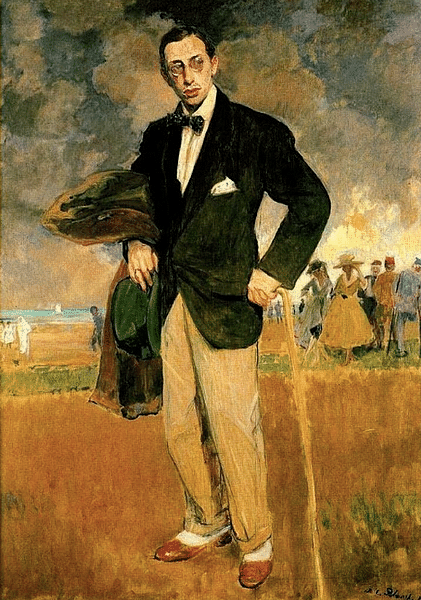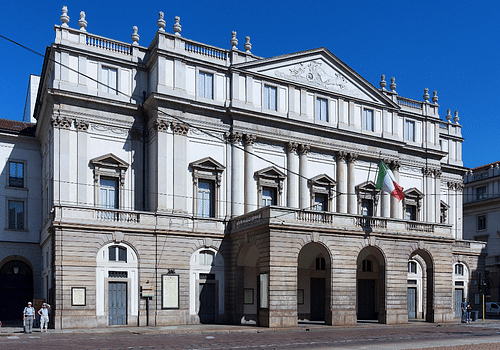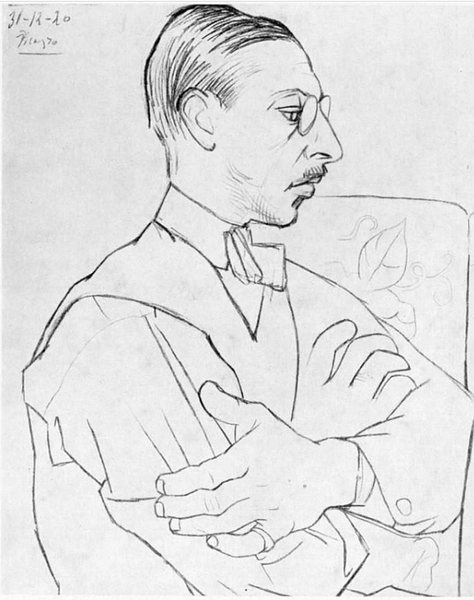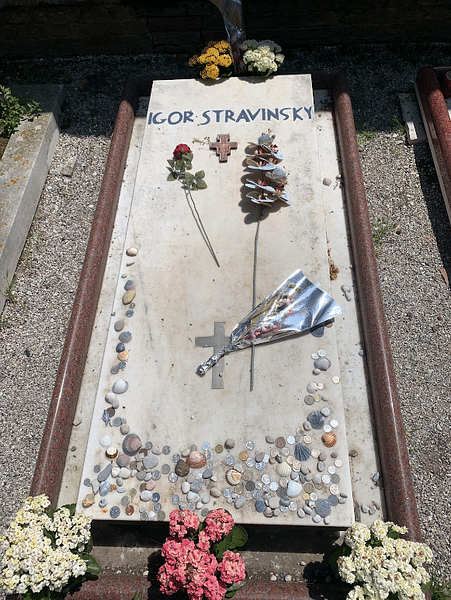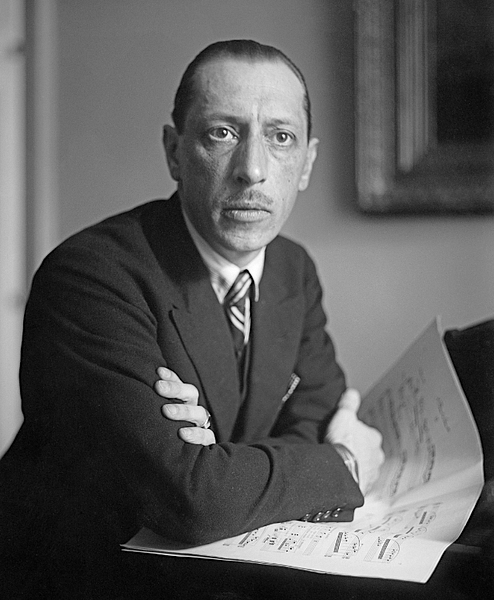
Igor Stravinsky (1882-1971) was a Russian composer best known for his works for the stage, such as the ballets The Firebird, Petrushka, and the groundbreaking The Rite of Spring. The modernist composer lived in Switzerland, France, and then the United States. Stravinsky's experiments with rhythms and dissonance have led to him being described as the 20th century's most important composer.
Early Life
Igor Stravinsky was born in Oranienbaum (now called Lomonosov) near St. Petersburg, Russia, on 17 June 1882. His father was a noted bass opera singer who performed at the Imperial Opera. Igor studied piano from age nine and, between 1903 and 1908, took private lessons from the Russian composer Nikolai Rimsky-Korsakov (1844-1908), the father of one of Stravinsky's school friends. Igor never studied in a formal institution of musical learning, but Rimsky-Korsakov was a master, particularly of orchestration, and he had encyclopedic knowledge of Russian folk music. At university, Stravinsky studied law, but he gave up these studies in 1905.
Stravinsky's first music works included a piano sonata, symphony, and Feu d'artifice (Fireworks), a dramatic orchestral piece composed in 1908. Early influences came from his mentor Rimsky-Korsakov and the inventive work of Claude Debussy (1862-1918).
The Diaghilev Ballets
Firebird
Stravinsky's major breakthrough came when the influential Ballets Russes impresario Sergei Diaghilev (1872-1929) saw performances of Scherzo fantastique and Feu d'artifice in St. Petersburg in 1909. Diaghilev commissioned Stravinksy to compose a ballet for performance in Paris. The composer gave him L'oiseau de Feu (Firebird), a work inspired by a Russian folk tale. Firebird was a great success at its premiere in June 1910 at the Paris Opéra. Stravinsky created various suites from the score in 1911, 1919, and again in 1945. Firebird is innovative, it uses the xylophone prominently, and although much more influential works would follow, it remains Stravinsky's most-played piece by modern orchestras.
Petrushka
The Stravinsky-Diaghilev partnership continued with the burlesque ballet Petrushka, described by M. Wade-Matthews as "a grotesque tale of lust and murder in a Russian puppeteer's booth" (466). It received its premiere in Paris in June 1911 and was another huge success. Stravinsky converted the score into an orchestral suite in 1914 and again in 1947, and he made a piano piece of it in 1921.
The Rite of Spring
A hat-trick of successes came with the ballet Le sacre du printemps (The Rite of Spring). The work tells the story of an ancient fertility rite involving the sacrifice of a virgin who must dance herself to death. Once again, it was commissioned by Diaghilev. The ballet was choreographed by Vaslav Nijinsky and premiered in Paris in May 1913 at the Théâtre des Champs-Elysées. The initial reaction to the innovative and dissonant score (clashing notes), deliberately ungraceful choreography, and the racy storyline was one of shock and outrage. The audience at the premiere went berserk. The composer Camille Saint-Saëns (1835-1921), when he heard the piece, described Stravinsky as crazy. Later performances earned a more respectful appreciation and even standing ovations.
The music critic P. Griffiths makes the following remarks on the piece's innovations:
Stravinsky's unleashing of new rhythmic force in The Rite of Spring was one of the great musical revolutions of the years before the First World War…By means of syncopation and rapid changes of metre Stravinsky did away with the regular pulse which had governed almost all Western music since the Renaissance: the rhythm now is angular and propulsive, the music's main motivating force.
(Arnold, 1757).
Imitating the driving rhythms of Russian folk music, Stravinsky promotes percussion from its usual support role to become the piece's driving element. The Encyclopedia of Classical Music explains Stravinsky's new approach to rhythm:
Most Western music before The Rite of Spring was written in regularly repeating patterns of two or three (or their multiples: four or six) beats to the bar. In The Rite Stravinsky used bars of five, seven, even 11 beats, and no less often changed the number of beats every bar; listeners are aware of powerful rhythm, but cannot tap their feet to it. (368).
Other striking innovations include the much greater use of dissonance than normal and the abandonment of using progressive keys. Debussy described his reaction to the overall effect by stating that he was "dumbfounded, overwhelmed by the hurricane that had come from the depths of the ages and taken life by the roots" (Sadie, 397). The Encyclopedia of Classical Music describes The Rite of Spring as "the most ground-breaking and revolutionary score of the century" (368). Stravinsky later converted some of the score of The Rite of Spring into a piano piece.
Opera & Beyond
In 1914, Stravinsky turned to opera, composing the three-act Le rossignol (The Nightingale), which was based on a fairy tale by Hans Christian Andersen (1805-1875). Once again it premiered in Paris. In 1919, Stravinsky repackaged The Nightingale's music into a symphonic poem titled Le chant du rossignol (The Song of the Nightingale). This piece was then choreographed into a ballet by Leonid Massine with the sets designed by no less a figure than Henri Matisse (1869-1954). The ballet premiered in Paris in 1920.
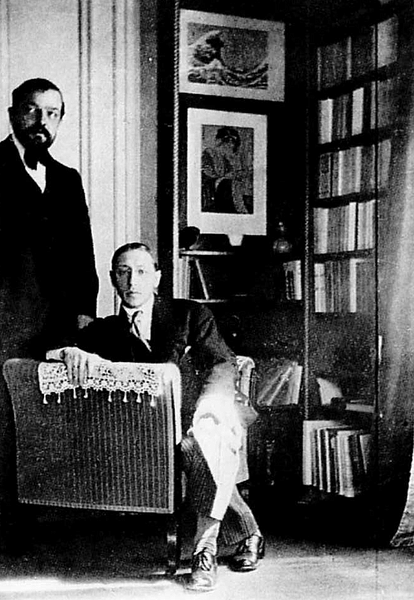
Following the outbreak of the First World War (1914-1918), Stravinsky relocated to Switzerland; he would not set foot in Russia again until 1962. He continued to compose, notably the ballet Les noces (The Wedding) and the burlesque Renard (Fox); both were based on Russian folk tales. These works illustrated Stravinsky's move into music that was devised for chamber ensembles, where the scores are much sparser. A good example of this new style is 1918's L'Histoire d'un soldat (The Soldier's Tale), which was composed for the eclectic mix of clarinet, bassoon, cornet, trombone, violin, and double bass. These musicians played for a four-part cast of three actors and one dancer while a narrator gave some clarity to what was happening. It is an early example of musical theatre and includes a tango, waltz, paso doble, and a ragtime tune. The ballet Pulcinella is of similar style; this work premiered in Paris in May 1920. The ballet again enrolled a famous artist for its set designs, this time Stravinsky's good friend Pablo Picasso (1881-1973), who also designed the costumes. Stravinsky again converted the score into a stand-alone suite, this time two versions, one for cello and piano and the other for violin and piano.
Stravinsky decided not to return to Russia, which was perhaps a wise decision given the tight state control on the arts in the USSR; Dmitri Shostakovich (1906-1975) was a notable victim of Soviet censorship in this period. Instead, Stravinsky settled in France, spending his time between Paris and the resort of Biarritz on the south-west coast.
Through the 1920s, Stravinsky concentrated on instrumental pieces, particularly piano pieces but not only. He dedicated Symphonies of Wind Instruments to Debussy in 1921. A final fling with Russian themes came with Mavra, a 1922 one-act comic opera inspired by the work of Alexander Pushkin (1799-1837). In 1924, he completed his Concerto for Piano and Wind. In 1927, Stravinsky composed a new opera, Oedipus Rex, which was based on a Jean Cocteau (1889-1963) text, which was itself based on the work of the Greek 5th-century tragedian Sophocles. Considered an opera-oratorio, the work was a mixed approach, which baffled audiences at first. Stravinsky wrote the ballet Apollon musagète (Apollo), which was commissioned not by Diaghilev but by Elizabeth Sprague Coolidge (1864-1953), a wealthy American and supporter of the arts. Another ballet, Le baiser de la fée (The Fairy's Kiss), was commissioned by Ida Rubinstein (1883-1960), the Russian former dancer and arts patron. The Fairy's Kiss was based on another story by Hans Christian Andersen, The Ice-Maiden, while the score is inspired by piano pieces and songs by Pyotr Ilyich Tchaikovsky (1840-1893).

In 1930, Stravinsky was commissioned to compose a piece to celebrate the Boston Symphony Orchestra's 50th anniversary. He composed Symphony of Psalms, a work for orchestra and chorus with the text in Latin from Psalms 38, 39, and 150. In 1931, he composed his Violin Concerto for the famed violinist Samuel Dushkin (1891-1976). In 1934, Stravinsky gained French citizenship, but commissions were now mostly coming from the United States, works like the ballet Jeu des cartes (The Card Game), which premiered in New York in 1937, the Symphony in C, and the Dumbarton Oaks concerto.
Character & Family
Although Debussy and Stravinsky admired each other's work, the Frenchman had this to say of the Russian in a letter to a friend: "He is a young barbarian who wears flashy ties and treads on women's toes as he kisses their hands" (Schonberg, 553). The Swiss writer C. F. Ramus, a collaborator of Stravinsky's, gives another insight into the composer's character and love of neatness: "Stravinsky's scores are magnificent. He is above all…a calligrapher…His writing desk resembled a surgeon's instrument case. Bottles of different coloured inks in their ordered hierarchy…One was reminded of the definition of St. Thomas: beauty is the splendor of order" (Schonberg, 558-9).
Stravinsky's personal life was as fluid as his musical tastes. He married twice and changed his nationality twice. In 1906, he married Katerina Nossenko, a cousin; the couple would go on to have four children. In the 1920s, he had an affair with the actress Vera Soudeikine, who was also married.
By 1939, as the storm clouds of war were gathering over Europe, Stravinsky suffered the triple tragedy of the deaths of his mother, first wife, and eldest daughter. Stravinsky decided to move to the United States. In 1940, the composer married Vera Soudeikine.
Life in the United States
Happy to stay permanently in the United States, Stravinsky applied for citizenship (granted in 1945) and set up home in Los Angeles. The work kept coming in, sometimes of an unusual nature like the Symphony in Three Movements, subtitled Circus Polka, which was commissioned in 1942 by the famous Barnum and Bailey Circus for their elephants to dance to. Stravinsky composed Scènes de ballet in 1944 for Broadway. The composer's eclectic tastes were further evidenced in his Ebony Concerto for Woody Herman (1913-1987), the celebrated jazz clarinettist. Stravinsky did not forget Europe; his opera The Rake's Progress was premiered in Venice in September 1951. The opera had three acts and a prologue with text by the poets W. H. Auden (1907-1973) and Chester Kallman (1921-1975). It was also staged at Milan's La Scala Theatre with Stravinsky conducting. This was the last orthodox work by the composer.
To supplement his income, which was reduced by a lack of copyright protection in the U.S. for his earlier works and the Soviet state's confiscation of his estate back in Russia, Stravinsky also played piano concerts himself, conducted, and recorded music.
Through the 1950s, Stravinsky adopted innovations first displayed by the Second Viennese School, which included Arnold Schoenberg (1874-1951). More experimental music included Canticum sacrum (1956), composed for tenor and baritone soloists plus choir and orchestra, which also reflected Stravinsky's definite turn to religious music, further evidenced in such works as the cantata Threni (Lamentations of the Prophet Jeremiah) for singers and orchestra, completed in 1958, and the 1961 cantata A Sermon, a Narrative and a Prayer. Stravinsky's final major work was Requiem Canticles for singers and orchestra; the composer described it as a "pocket Requiem" (Arnold, 1760).
Musical Style
Stravinsky changed his musical style throughout his career. Early on, he imitated the 'impressionism' of Debussy, but he soon set about creating unique works where his innovative use of rhythm beats through the pieces. As he once stated, "The percussion acts as a central heating system" (Wade-Matthews, 188). From around 1928, he moved into what is often called a neo-classical period since he reworked themes from some of the great composers of the past. He absorbed the baroque music of George Frideric Handel (1685-1759), the Brandenburg period of Johann Sebastian Bach (1685-1750), and the giant choruses of Giuseppe Verdi (1813-1901). These themes of old were then adapted and given Stravinsky's unique musical gestures so that the origins all but disappear. At the latter stage of his career, Stravinsky became highly interested in serialism and 12-note music, heard most clearly in the Threni cantata. This new style, innovated by Schoenberg, is described by S. Sadie as "a melodic style spread over extremes of register and a use of rhythm, derived from a detailed manipulation of small melodic and rhythmic cells, that disrupted any conventional notion of pulse" (441).
Stravinsky had some rather odd things to say about music, and his music, in particular. He once wrote: "I consider that music is, by its very nature, essentially powerless to express anything at all" (Steen, 691). A strange comment from a composer famous precisely for his powers of expression, but what he meant was music is simply music, reading meaning into it (as Romantics like to do) is an entirely subjective act. Much is made of how exactly can an untutored listener make any sense of Stravinsky's more challenging pieces. The composer himself once said, "My music is best understood by children and animals" (Wade-Matthews, 86), and he recognised that his later works had "estranged me from the great mass of listeners…They cannot and will not follow me in the progress of my musical thought" (Schonberg, 558). Stravinsky certainly had his critics. Sergei Prokofiev once described Stravinsky's work as "Bach on the wrong notes" (Wade-Matthews, 466).
Stravinsky's Major Works
The most important works by Igor Stravinsky include (with first performance date indicated in brackets) :
Fireworks – orchestral work (1908)
Fantastic Scherzo – orchestral work (1909)
The Firebird – ballet (1910)
Petrushka – ballet (1911)
The Rite of Spring – ballet (1912)
The Nightingale – opera (1914)
The Wedding – ballet (1923)
The Soldier's Tale – for soloists, actors, and dancer (1918)
Pulcinella – ballet (1920)
Oedipus Rex – opera (1927)
The Fairy's Kiss – ballet (1928)
Symphony of Psalms – for chorus and orchestra (1930)
Dumbarton Oaks – concerto (1938)
Symphony in Three Movements or Circus Polka (1942)
The Rake's Progress – opera (1951)
Canticum sacrum – for soloists, choir, and orchestra (1956)
Threni – cantata (1958)
Requiem Canticles (1966)
Death & Legacy
Stravinsky moved to New York in 1969. In his final years, the composer, in collaboration with Robert Craft, wrote several books, which covered his own career and assessed the works of other composers. There is still much debate as to how much of these works is Craft and how much Stravinsky. Stravinsky died in New York on 6 April 1971 but was buried in Venice not far from the grave of Diaghilev in the cemetery on the island of San Michele.
Stravinsky had "produced a string of original masterpieces, constantly re-inventing his style to accommodate changing tastes" (Wade-Matthews, 262). The Rite of Spring remains ever-popular as an orchestral piece, it even appeared in the Walt Disney film Fantasia (1940), much to the composer's disapproval of how it was used, principally because of the cuts made.
Stravinsky's works influenced many other composers, notably Aaron Copland (1900-1990), Manuel de Falla (1876-1946), Gian Francesco Malipiero (1882-1973), Frank Martin (1890-1974), and Hanz Werner Henze (1926-2012). Indeed, a list of composers not in some way influenced by Stravinsky would be very short. The Rite of Spring was perhaps the single most influential piece of music of the 20th century because Stravinsky "denied all the rules of composition text-books, but liberated melody, harmony, counterpoint and rhythm from those rules" (Sadie, 369). Music was never quite the same again.
